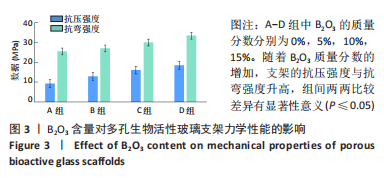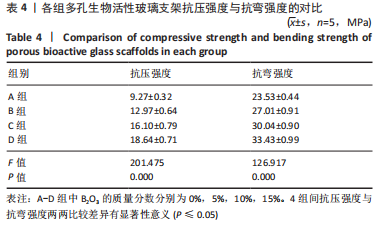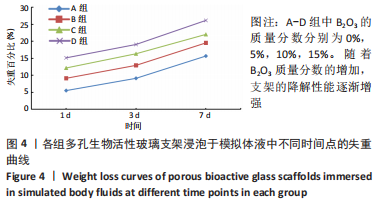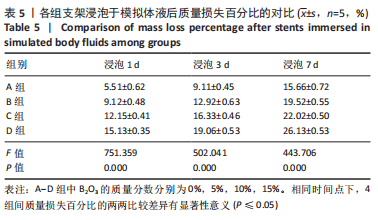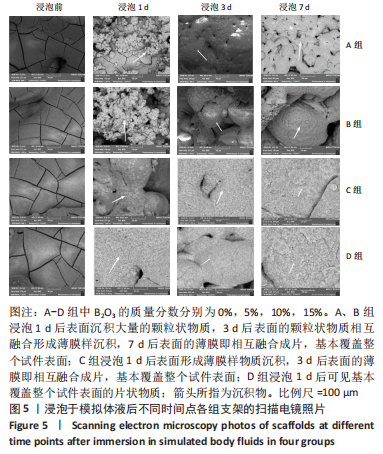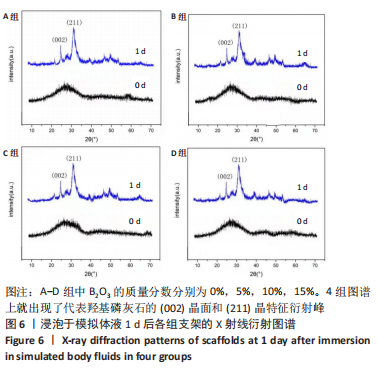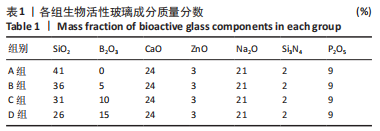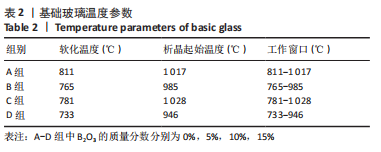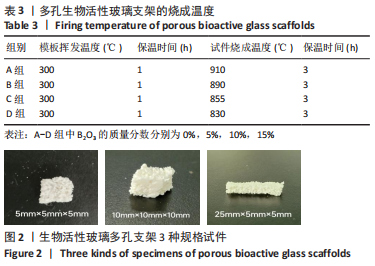中国组织工程研究 ›› 2024, Vol. 28 ›› Issue (5): 712-716.doi: 10.12307/2024.264
• 材料力学及表面改性 material mechanics and surface modification • 上一篇 下一篇
不同含量B2O3对生物活性玻璃支架力学性能与生物活性的影响
王建春1,杨树青2,苏 欣2,王宏远2
- 1赤峰学院附属医院,内蒙古自治区赤峰市 024000;2内蒙古医科大学第四附属医院口腔科,内蒙古自治区包头市 014032
Different contents of B2O3 affect mechanical properties and bioactivity of bioactive glass scaffolds
Wang Jianchun1, Yang Shuqing2, Su Xin2, Wang Hongyuan2
- 1Affiliated Hospital of Chifeng University, Chifeng 024000, Inner Mongolia Autonomous Region, China; 2Department of Stomatology, Fourth Affiliated Hospital of Inner Mongolia Medical University, Baotou 014032, Inner Mongolia Autonomous Region, China
摘要:
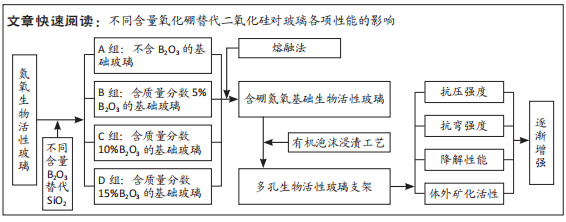
文题释义:
氮氧生物活性玻璃:是一种以硅酸盐类CaO-SiO2为基础的人工骨修复替代材料,由硅、钙、磷和钠的氧化物组成CaO-SiO2-P2O5系统,最早由 HENCH发现并命名,而氮氧生物活性玻璃是对基础玻璃进行过氮化处理,提高了其力学性能。人工合成骨替代材料:此类研发的骨替代生物材料拥有诸多优点,被植入到骨缺损部位后能为新骨的形成提供理想的机体微环境,同时使成骨细胞拥有一个可依附的稳定三维空间,且原料易获取、成本低廉。
背景:生物活性玻璃骨修复材料具有骨结合能力、骨诱导能力及骨传导特性,但目前生物活性玻璃的性能尚不符合临床应用要求,添加硼元素有望改善生物活性玻璃的性能。
目的:研究不同含量B2O3替代SiO2对生物活性玻璃力学性能及生物活性的影响。方法:以含磷氮氧生物活性玻璃(成分为:SiO2-CaO-ZnO-Na2O-Si3N4-P2O5)为基础,以B2O3部分替代其中的SiO2,采用高温熔融法烧制含B2O3质量分数分别为0%(A组),5%(B组),10%(C组),15%(D组)的基础玻璃(基础玻璃中SiO2与B2O3的质量分数总和为41%),采用有机泡沫浸渍法制作多孔生物活性玻璃支架,利用万能力学试验机单轴压缩和三点弯曲法测试力学性能;将4组支架浸泡于模拟体液中,检测支架的降解性能,利用扫描电镜观察浸泡前后支架的形貌变化,以及X射线衍射分析浸泡前后的支架物相组成。
结果与结论:①随着B2O3质量分数的增加,多孔生物活性玻璃支架的抗压强度与抗弯强度升高,4组支架的抗压强度与抗弯强度比较差异有显著性意义(P ≤ 0.05);②浸泡于模拟体液中后,随着时间的延长,多孔生物活性玻璃支架逐渐降解;相同浸泡时间点下,随着B2O3质量分数的增加,支架的降解速率加快,4组支架的抗压强度与抗弯强度比较差异有显著性意义(P ≤ 0.05);③浸泡于模拟体液后的扫描电镜显示,A、B组浸泡1 d后表面沉积大量的颗粒状物质,3 d后表面的颗粒状物质相互融合形成薄膜样沉积,7 d后表面的薄膜即相互融合成片,基本覆盖整个试件表面;C组浸泡1 d后表面形成薄膜样物质沉积,3 d后表面的薄膜即相互融合成片,基本覆盖整个试件表面;D组浸泡1 d后可见基本覆盖整个试件表面的片状物质;④浸泡于模拟体液中1 d后的X射线衍射分析显示,4组支架表面的沉积物为结晶态的羟基磷灰石;⑤B2O3替代部分SiO2会增强多孔生物活性玻璃支架的力学性能、降解性能及体外矿化活性。
https://orcid.org/0000-0001-9458-928X(王建春)
中国组织工程研究杂志出版内容重点:生物材料;骨生物材料;口腔生物材料;纳米材料;缓释材料;材料相容性;组织工程
中图分类号:
